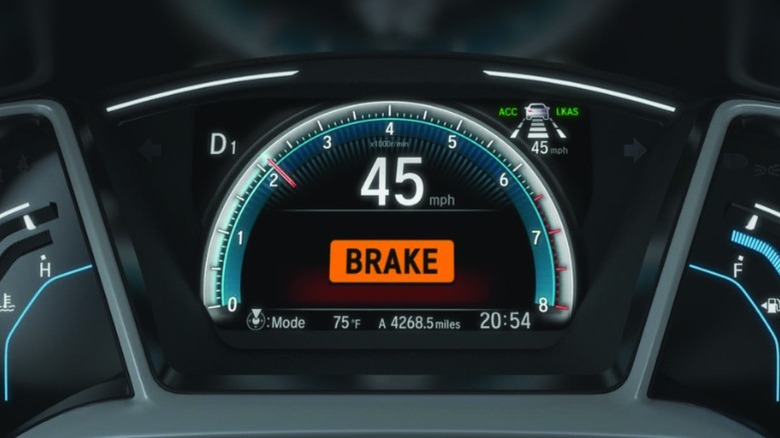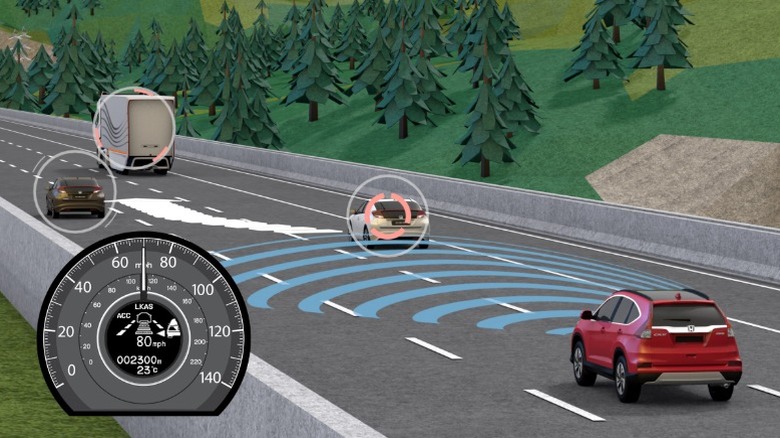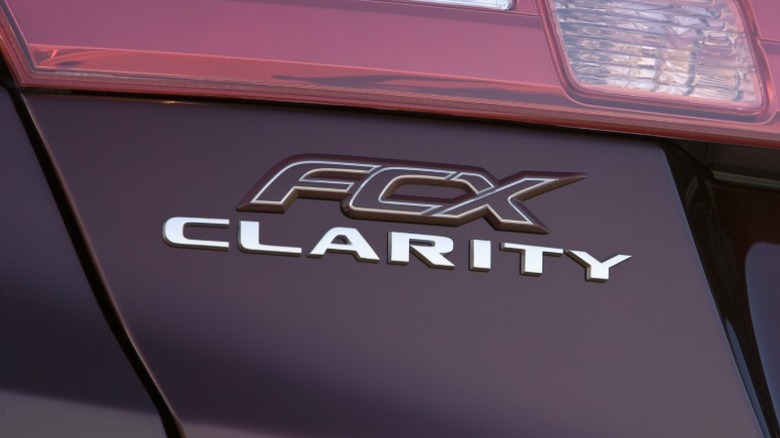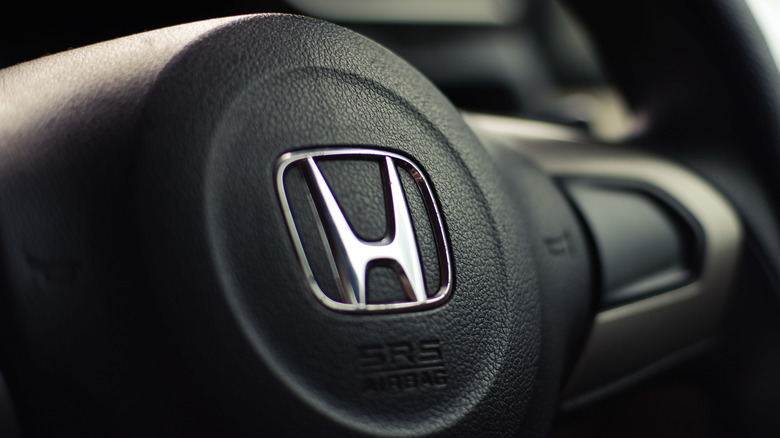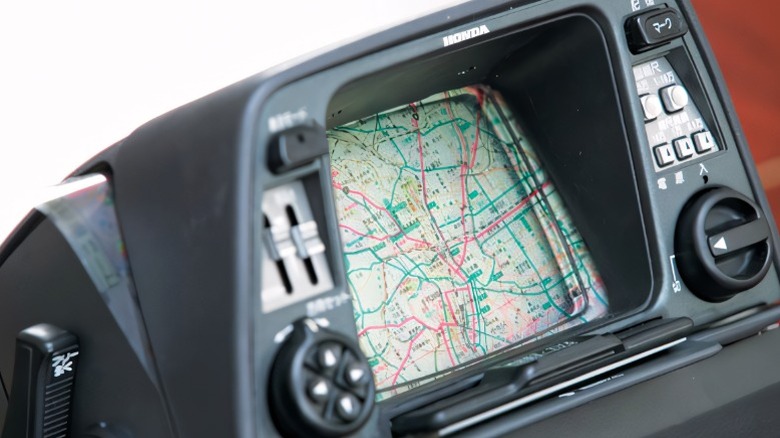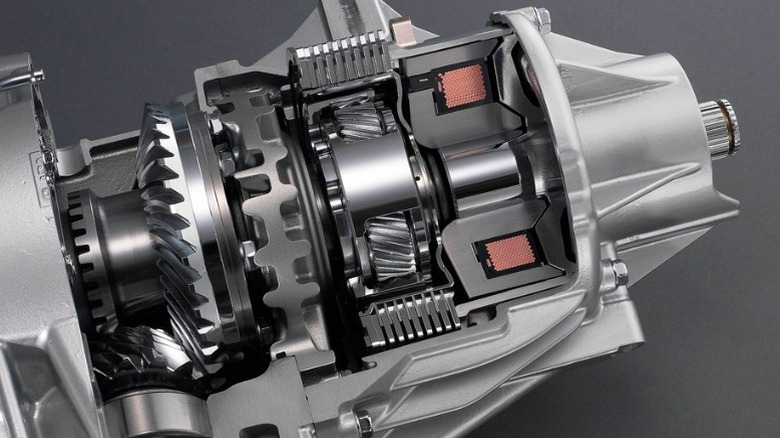9 Car Technologies Honda Pioneered
Honda has come a long way since Soichiro Honda founded it in post-war Japan. Starting with affordable, compact motorcycles, the company would slowly establish itself as a major player in the automotive world over the next few decades, thanks in larger part to its most successful models, like the Civic and Accord, which it brought to market in the 1970s.
But Honda hasn't just built its fame selling lots of cars. The firm has also been at the forefront of car technology, pioneering new features that may now seem familiar, but were once on the cutting edge. Even casual gearheads will know that Honda introduced VTEC to the world. Many will also be aware that it paved the way for mass-produced hydrogen fuel cell vehicles via the FCX Clarity. We'll discuss those, of course, but there's far more to Honda's pioneering contributions to car technology than those two. For example, it also played a significant role in the development of vehicle safety features, and it was the first company to introduce an in-car feature that we now take for granted. Let's take a closer look.
Automatic emergency braking
For all its strengths, Honda perhaps doesn't quite have the same safety track record as Volvo or Subaru for those seeking safety above all. However, it's made a few crucial contributions to car safety over the years, one of which is automatic emergency braking.
Advanced driver assistance systems (ADAS) are all the rage now, but back in the early 2000s, heavily automated safety tech like Subaru's Eyesight and Honda Sensing was nothing more than a distant fantasy. Sure, LiDAR-guided cruise control had been around since the early 1990s, but that was about it — at least, until 2003. In May of that year, Honda announced its Collision Mitigation Brake System (initially abbreviated CMS, now CMBS) to the world, set to debut on the Japan-market Inspire. Honda's CMS used a radar system that worked with various electronic systems, such as an ECU and a Variable Signal Analyzer (VSA), to analyze traffic and predict collisions. If the system detected that a crash was unavoidable, it would tighten the seatbelt and apply automatic emergency braking.
However, while Honda can lay claim to pioneering the tech, it would not be the first automaker to bring it to the U.S. Instead, that honor goes to Mercedes-Benz, which introduced automatic emergency braking on the 2005 S-Class in North America. Volvo would follow suit a few years later, with the 2008 XC60 coming equipped with an automatic braking feature. All three received Euro NCAP awards for their automated braking systems in 2010, and Honda would later integrate CMBS into its Honda Sensing safety suite.
Predictive cruise control
As we briefly mentioned earlier, adaptive cruise control (ACC) is by no means a new technology. It wasn't even new at the turn of the millennium, with Mitsubishi having introduced ACC on JDM versions of its Diamante sedan in 1992. Toyota followed suit a few years later, and Mercedes-Benz was hot on its heels, bringing Distronic cruise control to its S-Class in 1998. Honda was, it seems, quite late to the game of basic ACC, but it would eventually leave its own mark on the technology.
In early 2015, the Japanese giant announced that the European Honda CR-V would receive Intelligent Adaptive Cruise Control (i-ACC), which was the company's evolution of the standard ACC technology. Honda's i-ACC used a camera and radar to detect other vehicles on the road, which fed an algorithm that predicted whether they would cut into a lane up to five seconds before it happened. This allowed the system to slow the vehicle down gradually, allowing the other car to change lanes safely without upsetting the Honda driver or their passengers with sudden braking.
It's worth noting that Honda's predictive cruise control — which is now part of Honda Sensing's ACC and is one of the many Honda safety features cautious drivers should know about — was nothing like the contemporary GPS-based predictive cruise control systems from Mercedes-Benz and Volkswagen. These used map data to shift gears and even slow the car down for bends with cruise control engaged, which was a whole other use of the word "predictive."
CVCC
Enough safety talk for now; let's turn our attention to some of Honda's innovations in the engine bay. First, let's look at CVCC, Honda's contribution to post-Clean Air Act 1970s motoring. With American automakers struggling to adapt to changing regulations and a crushing oil crisis, leading to terrible 1970s cars like the '74 Ford Thunderbird, Honda's CVCC allowed the Japanese automaker to offer a valuable alternative that helped establish the company in North America.
Honda's CVCC was a unique engine technology for the time, debuting in 1972 as the first production engine to comply with not just the 1970 Clean Air Act, but also the stricter regulations coming in 1975. Honda managed this by using a pre-combustion chamber, which housed a spark plug that ignited a small amount of fuel. The flame from the explosion would then ignite a much leaner fuel mix in the main cylinder block, resulting in much cleaner and more efficient combustion. It worked well enough that Honda's 1972 CVCC engine managed to get by without a catalytic converter at all. This, in turn, meant that buyers could use leaded or unleaded fuel depending on what was available; quite a boon during an oil shortage.
Of course, Honda's CVCC engine wasn't powerful, with 1974 Civics boasting 53 hp and 69 lb-ft of torque. But that wasn't the point: the CVCC was clean (for the time) and got anywhere between 41 and 54 mpg on the highway, based on EPA estimates — crucial in an era when gasoline could cost up to 55 cents a gallon (or $3.56 in 2025).
Mass-market hydrogen fuel cell vehicles
CVCC wasn't Honda's only contribution to clean motoring, although it would take quite a few decades until its next major introduction, that of mass-produced hydrogen fuel cell vehicles. Now, to be clear, Honda did not develop hydrogen fuel cell vehicles; GM had already achieved it as early as 1966 with a fuel cell-powered prototype van called the Electrovan. Many other companies, such as Mercedes-Benz and BMW, would also follow in GM's footsteps. However, these were almost entirely prototype or demonstration cars not meant for public use. But that all changed when Honda turned its hand to the hydrogen fuel cell vehicle around the turn of the millennium.
Starting from a 1999 prototype, Honda eventually provided a handful of its FCX fuel-cell vehicles to select Japanese government bodies and the City of Los Angeles in 2002. It followed this up by obtaining certification from the Japanese Ministry of Land, Infrastructure and Transport for its FCX in 2005, essentially paving the way for full production. Three years later, Honda started building the FCX Clarity, becoming the first automaker to engage in mass production of a hydrogen fuel cell vehicle.
Sadly for those who had pinned their hopes on the technology, hydrogen fuel cell vehicles haven't quite caught on in the years since. There are only three hydrogen-powered vehicles available in the U.S. in 2025, with Honda's new CR-V e:FCEV competing with offerings from Hyundai and Toyota. Despite that, Honda continues to push the tech forward, and introduced a next-generation fuel cell module in early 2025.
VTEC
Let's discuss the Honda technology most of you have probably been expecting: VTEC. Variable Valve Timing and Lift Electronic Control was Honda's way of squeezing out as much power as possible from its compact engines, without resorting to turbos or other power-adders, and has featured in most of the automaker's engines since it debuted on the JDM Honda Integra XSi in 1989.
While we won't go too deep into how Honda's VTEC system works, the basic principle is that it uses multiple cam lobes for the engine's valves; two are tuned for daily low-rpm driving, while the center one is tuned for higher-rpm power. As engine revs increase, the car's ECU shifts between the low-power cam lobes and the central lobe, increasing horsepower. The result on the 1989 Integra XSi, for example, was 160 hp from a 1.6-liter engine, achieving Honda designers' goal of 100 hp per liter.
VTEC would eventually make its way stateside in 1991 with the Acura NS-X, but the more affordable 160-hp Integra GS-R from 1992 is probably the car that made VTEC the household name that it is. Honda has continued to update VTEC over the decades, with i-VTEC from the early 2000s currently used in most of Honda's offerings. Honda has also combined VTEC with turbos, leading to a double whammy of goodness that our Chris Davies loved when he reviewed the 2023 Honda Civic Type R.
i-SRS airbag
VTEC is probably the highlight of Honda's offerings to the automotive world, but its other contributions are still plenty helpful. Take, for example, the i-SRS airbag, which Honda brought to market in 2008 for the Japanese-market Life. This airbag wasn't necessarily a revolutionary change, but it was still a world-first, so it makes it onto this list.
The i-SRS airbag was built around what Honda called "continuously staged inflation." In essence, Honda's revised airbag didn't just inflate the driver's side airbag immediately; instead, it filled up the airbag in stages, which the automaker claimed would improve driver comfort and safety in the event of a crash. The i-SRS airbag also stayed active longer, according to Honda, which was likely another boon for anyone unfortunate enough to have their airbags deploy in a crash.
Honda had also pioneered airbag tech in Japan in 1987, becoming the first Japanese automaker to offer airbags in a Japanese automobile with that year's Legend. However, in an inversion of the usual tale of tech innovations, Honda was more than a decade late, with airbags having debuted in American cars of the 1970s, such as the Mercury Monterey from 1972 and 1974's Oldsmobile Toronado Brougham.
Intelligent night vision
If you find safety tech dull, you'll probably want to skip this one, but it was still a first, and one that eventually caught on (in a way), so we think it's worth discussing. In 2004, Honda announced that it had developed an intelligent night vision system that it claimed was a world first. While night vision had been around for a few years by then, with Cadillac's Deville first showcasing the tech in 2000, Honda ramped up the safety factor by enabling its night vision to help drivers actively.
To understand the context a bit better, we have to look at the Cadillac Deville's night vision. Cadillac's system, as impressive as it was for the time, merely projected a night-vision image onto the car's head-up display. Sure, the image highlighted warm (and warm-blooded) objects, but it was still up to the driver to parse the image. On the other hand, Honda's system, which debuted on the 2004 JDM Honda Legend, could identify pedestrians by interpreting the image captured by the sensors. It would then alert the driver to their presence.
As with Honda's automatic emergency braking tech, other automakers would soon join the fray and introduce their versions of the technology. Toyota introduced pedestrian-detecting night vision in 2008, while Mercedes-Benz brought the feature to its cars in 2009.
In-car navigation
Love them or loathe them, infotainment systems are here to stay. Modern cars keep bringing bigger and bigger screens every year, and we don't think there's any going back to the good old days of tactile controls and mostly distraction-free driving. And while Honda may not rank among the market leaders in modern infotainment systems, nobody can else can claim credit for introducing the first-ever map-based in-car navigation system. And it debuted in 1981, more than a decade before GPS came into existence.
Honda managed this admirable feat using an invention its engineers called the Electro Gyrocator. This was a helium gyroscope that, combined with a transmission-mounted sensor, used inertial navigation to track a vehicle's heading. It then displayed this data on a dash-mounted CRT screen along with the route the driver was to follow. The maps themselves were custom-made transparencies overlaid on top of the CRT — which meant that, yes, the driver or passenger would have to swap maps every time the car reached the edge of one map.
Honda only offered the Electro Gyrocator on the 1981 Accord and Vigor, and it was an expensive option; the system allegedly cost nearly a quarter of the price of an entire Accord. It's probably no surprise, then, that the company started working on next-gen navigation systems in 1982, focusing on both analog and digital implementations. Honda gave up on analog navigation systems in 1985, but eventually debuted its first digital in-car navigation system in the 1990 Honda Legend.
Torque-vectoring all-wheel-drive
Honda has developed many fun and sporty cars over the years. The modern Civic Type R is one example, as are the incredibly special NSX Type R and the gloriously high-revving Honda S2000. But these are all two-wheel-drive cars, so it's easy to overlook Honda's role in the development of all-wheel-drive technology. Honda didn't even come close to making the first AWD car, but it can lay claim to one innovation: torque vectoring. Well, in a way.
You see, Honda first introduced torque vectoring in 1996 on the Honda Prelude, the same year that Mitsubishi introduced the tech to the Lancer Evolution IV. But the Lancer was AWD, while Honda's offering was FWD — so, one could justifiably argue that Mitsubishi deserves credit for this particular innovation. However, Mitsubishi opted for a fixed 50-50 split between the front and rear wheels on the Evo IV (and would continue to do so until the Evo VIII, at least), which is where Honda comes into the picture once again.
Honda introduced the Super Handling All-Wheel Drive (SH-AWD) system in 2004, which integrated rear-axle torque vectoring into a system that also actively distributed power between the front and rear axles as necessary. Honda's SH-AWD debuted in the 2005 Acura RL and Honda Legend in North America and Japan, respectively. Other companies would eventually join in the fun: Engineering and drivetrain firm Ricardo introduced a torque-vectoring AWD system in 2006, while Audi added the feature to its Quattro AWD system in 2008.

